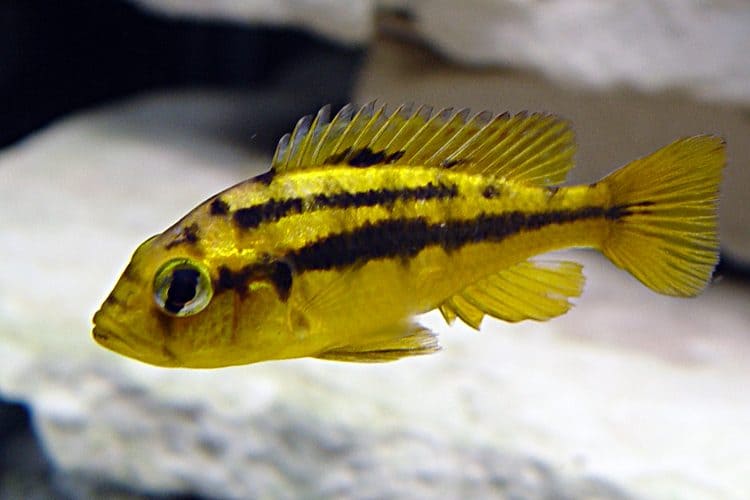I purchased a sextet of half-grown Yellow-cheeked Kribensis at a DSAS auction. They turned out to be four males and two females. As with the garden variety Kribensis, P. pulcher, the females are more colorful, sporting the yellow cheeks for which they are named as well as more yellow on the end of the tail and the upper half of the caudal fin where there are also numerous black spots. The spotting is also found on the back half of the dorsal fin. The males have some yellow on the cheeks, but are more pastel colored that the females, with extensions on the unpaired fins and no spots. The dorsal fin of the male is edged with red, below which is a band of lavender. Male coloration seems more mood-dependent than in the females. Both sexes get the pinkish red abdominal coloration when in breeding/territorial mode. I have to admit my limitations in describing these fish on paper but, in general, I find them more pleasantly colored than P. pulcher.

They were placed in a 20-gallon long aquarium that was filtered by an undergravel filter run by a powerhead. Lighting consisted of one 20 watt full spectrum fluorescent tube on a timer that kept the tank lit for approximately 10 hours daily. Temperature was a fairly constant 78F degrees, pH ranging from neutral down to 6.0 depending on my sometimes erratic water changing schedule. Hardness obviously varied with the pH my well water starts out fairly hard (not measured specifically for a long time) with a pH of 7.5. These fish and their fry seemed unfazed by this range of conditions, despite the conditions they inhabit in the wild. Companion life-forms in the tank were 5 or 6 white clouds, two full-grown whiptail catfish, a large cutleaf watersprite and a number of Cryptocoryne wendtii. There were also four terracotta flower pots on their sides, a length of PVC pipe and a few rocks in there caves aplenty! Foods consisted of a mixture of flake, pellet, freeze-dried and frozen fare. Picky eaters these fish are not.
These fish bred successfully for me twice. Each time the pair colored up significantly and became very territorial, particularly around their chosen cave. The female stayed inside the cave most of the time, with the male patrolling the perimeter. While not particularly violent at this time, they made it quite clear to their tankmates that there was a point beyond which they had best not trespass. These observations were made somewhat in retrospect since I could never be sure they had actually bred until they emerged with the free-swimming cloud of fry. The cave entrances all faced the back of the tank. Once they emerged with the fry, it became necessary to remove the other male Kribensis since they got no rest from the breeding male. The other fish were not pursued as vigorously and were left in the tank. The fry seemed to find plenty of microscopic food items in the dense growth of algae on the tank furnishings when they first emerged. This was supplemented with frozen brine shrimp nauplii, powdered fry food, and what they ate of their parents fare. As with the adults, it was not difficult keeping their bellies full, and they grew quickly because of that.
While I said the fish bred successfully twice, the fish keeper was only successful the second time. With the first spawning, I removed the parents only a couple of days after the fry emerged from the cave. Big mistake! While the fry could feed themselves and move around the tank readily, they apparently still needed their mothers signals to know when to move out of the way of danger. The danger in this case came from a few bronze corys that ate the whole spawn the first night the parents were gone. The babies just hung on the bottom, not knowing when to get out of the way! The second time, the parents were not removed until the babies started to venture away on their own after a couple of weeks. I dont have any idea how many fry were produced in the first spawning, but the second time a total of 60-65 were accounted for by the time all were sold or otherwise dispersed.
Although some will say breeding Kribensis is a matter of simply adding fish and water, but for one whose experience with dwarf cichlids is limited, these yellow-cheeked kribs demonstrated all of the typical cichlid spawning behavior on a smaller scale and provide an attractive variation of a common genus. I would definitely recommend them for anyone interested in dwarf African cichlids.
Leave a Reply